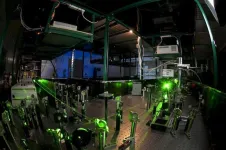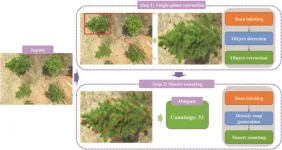(Press-News.org) New research has revealed that Rembrandt impregnated the canvas for his famous 1642 militia painting ‘The Night Watch’ with a lead-containing substance even before applying the first ground layer. Such lead-based impregnation has never before been observed with Rembrandt or his contemporaries. The discovery, published today in Science Advances, underlines Rembrandt's inventive way of working, in which he did not shy away from using new techniques.
The surprising observation is yet another result from Operation Night Watch, the largest and most wide-ranging research and conservation project in the history of Rembrandt’s masterpiece. It resulted from advanced analysis of an actual paint sample taken from the historical painting. First author of the paper is Fréderique Broers, a researcher at the Rijksmuseum and PhD student with professors Katrien Keune (University of Amsterdam), Koen Janssens (University of Antwerp) and Florian Meirer (Utrecht University). Her research forms part of the research project 3D Understanding of Degradation Products in Paintings of the Netherlands Institute for Conservation+Art+Science+ (NICAS), funded by the Dutch Research Council NWO. Broers and coworkers employed a combination of x-ray fluorescence and ptychography to identify and visualize sub-microscale chemical compounds in the lower layers of the canvas. By sampling the small Night Watch paint fragment at DESY (Deutsches Elektronen-Synchrotron, Hamburg), they discovered the lead-rich layer below the quartz-clay ground layer of the canvas.
Protection against moisture
It was already known from earlier studies that Rembrandt had used a quartz-clay ground on the Night Watch. In earlier paintings he had used double grounds, consisting of a first ground containing red earth pigments followed by a second lead white containing ground. The large size of The Night Watch may have motivated Rembrandt to look for a cheaper, less heavy and more flexible alternative for the ground layer. Another issue he had to overcome was that the large canvas was intended for a damp outer wall of the great hall of the Kloveniersdoelen (musketeers’ shooting range) in Amsterdam. It had been reported that under humid conditions the common method of preparing the canvas using animal glue could fail. A contemporary source on painting techniques written by Théodore de Mayerne suggested impregnation with lead-rich oil as an alternative. This may have inspired Rembrandt for his unusual impregnation procedure to improve the durability of his masterpiece.
Computational imaging
The presence of this lead-containing ‘layer’ was discovered by the first-ever use of correlated x-ray fluorescence and ptychographic nano-tomography on a historical paint sample. This was performed at the PETRA III synchrotron radiation source at DESY. X-ray fluorescence is used to investigate the distribution of relatively heavy elements (calcium and heavier). Ptychography, a computational imaging technique based on experimentally obtained datasets, is capable of visualizing even the lightest elements and organic fractions.
Analysis of the micro sample taken from The Night Watch revealed that on the side of the sample closest to the canvas support a homogenous layer of dispersed lead was present in the ground layer. Since lead components were not to be expected in the quartz-clay ground layer, this was a rather puzzling observation. The results were then combined with the lead distribution map of the full Night Watch, obtained by X-ray fluorescence scanning of the painting in the Rijksmuseum’s Gallery of Honour. This map reveals the presence of lead throughout the painting and suggests application using large semi-circular brushstrokes, supporting the assumption that it results from an impregnation procedure. Even an imprint of the original strainer onto which the canvas was stretched when the preparatory layers were applied, is visible in the lead distribution map. This brings us yet another step closer to understanding Rembrandt’s creative process in painting The Night Watch, as well as its current condition.
Publication details
Fréderique T.H. Broers, Ige Verslype, Koen W. Bossers, Frederik Vanmeert, Victor Gonzalez, Jan Garrevoet, Annelies van Loon, Esther van Duijn, Anna Krekeler, Nouchka De Keyser, Ilse Steeman, Petria Noble, Koen Janssens, Florian Meirer, Katrien Keune: Correlated x-ray fluorescence and ptychographic nanotomography on Rembrandt’s The Night Watch reveals unknown lead “layer”. Science Advances, 15 December 2023. DOI: 10.1126/sciadv.adj9394
Contact
Lead author: Fréderique Broers, F.Broers@rijksmuseum.nl
END
Rembrandt broke new ground with lead-based impregnation of canvas for The Night Watch
2023-12-15
ELSE PRESS RELEASES FROM THIS DATE:
SFU and UBC researchers receive $1.25 million to study cumulative effects on B.C. salmon
2023-12-15
Salmon researchers from British Columbia are embarking on a three-year study to understand and help mitigate the cumulative threats affecting the vulnerable species in the province’s watersheds.
The Watershed Futures Initiative, which includes researchers from Simon Fraser University, University of British Columbia and University of Montana, has received $1.25 million from the federal and provincial governments – through the joint British Columbia Salmon Restoration and Innovation Fund – to tackle the combined impacts of logging, mining, urban development, agriculture, climate change and other factors on salmon.
While ...
Endocrine-disrupting chemicals found in menstrual products including tampons, pads, and liners
2023-12-15
The average menstruator will use over 11,000 tampons or sanitary pads in their lifetime. Vaginal and vulvar tissue that touch pads and tampons is highly permeable. Through this permeable tissue chemicals are absorbed without being metabolized, which makes endocrine-disrupting chemicals potentially dangerous when found in menstrual products. Endocrine-disrupting chemicals can interfere with human hormones and cause medical issues, including gynecological conditions such as endometriosis and uterine fibroids.
Joanna Marroquin, a Mason PhD in Public Health student, and Associate ...
Five researchers named Argonne Distinguished Fellows for 2023
2023-12-15
The U.S. Department of Energy’s (DOE) Argonne National Laboratory has named five highly accomplished scientists as Argonne Distinguished Fellows in 2023. They are Glenn Decker, Paul Fenter, Robert Fischetti, Sven Leyffer and Valentine Novosad.
The honor recognizes scientists who have not only achieved international esteem but who have also demonstrated exceptional achievements in science or engineering relevant to Argonne’s core missions. They are leaders of major, complex, high-priority projects or programs that have an impact on the future of the Laboratory. Only a small ...
Study shows exposure to household chemicals can lower odds of getting pregnant
2023-12-15
Exposure to phthalates, a group of plasticizing and solvent chemicals found in many household products, was linked to a lower probability of getting pregnant, but not to pregnancy loss, according to research by a University of Massachusetts Amherst environmental and reproductive epidemiologist.
The study, published this week in the journal Environmental Health Perspectives, also noted an association between preconception exposure to phthalates and changes in women’s reproductive hormones, as well as increased inflammation and oxidative stress.
“Phthalates ...
NRL’s Debra Rolison elected 2023 National Academy of Inventors Fellow
2023-12-15
WASHINGTON – Debra Rolison, Ph.D., of the U.S. Naval Research Laboratory (NRL) has been named Fellow of the National Academy of Inventors (NAI), for having demonstrated a highly prolific spirit of innovation in creating and facilitating outstanding inventions that have made a tangible impact on the quality of life, economic development, and welfare of society.
Rolison has been at the lab for over 43 years and heads the Advanced Electrochemical Materials section. The recognition by the NAI is attributed to the efforts made by her team’s inventions related to a new form factor for zinc anodes in rechargeable ...
North America’s first people may have arrived by sea ice highway
2023-12-15
SAN FRANCISCO — One of the hottest debates in archeology is how and when humans first arrived in North America. Archaeologists have traditionally argued that people walked through an ice-free corridor that briefly opened between ice sheets an estimated 13,000 years ago.
But a growing number of archeological and genetic finds — including human footprints in New Mexico dated to around 23,000 years old — suggests that people made their way onto the continent much earlier. These early Americans likely traveled along the Pacific coastline from Beringia, the land bridge between Asia and North America ...
Xinfeng Gao named 2024 AIAA Associate Fellow
2023-12-15
We are pleased to announce that the American Institute of Aeronautics and Astronautics (AIAA), a preeminent aerospace professional society, has selected professor Xinfeng Gao to be a member of the class of 2024 AIAA associate fellows. Only one member of the Institute for every 150 members is selected as an associate fellow each year by the review committee.
“This recognition illustrates the impact of our outstanding faculty. Aerospace engineering at UVA continues on a great trajectory and professor Gao is a big part of that,” said Richard W. Kent, professor and chair of the Department of Mechanical and Aerospace Engineering.
Pioneering ...
Substance-abuse stigma impedes treatment in various ways, scientists say
2023-12-15
Addiction is one of society’s most misunderstood and rebuked health conditions. That stigma discourages many people from seeking treatment for substance dependence, according to a new report published in Psychological Science in the Public Interest, a journal of the Association for Psychological Science.
Research on stigma toward people with substance use disorder (SUD) is relatively sparse, the report adds.
“Characterizing the nature and etiology of SUD stigma is critical for developing tailored and effective interventions ...
Ultrafast lasers map electrons 'going ballistic' in graphene, with implications for next-gen electronic devices
2023-12-15
LAWRENCE — Research appearing in ACS Nano, a premier journal on nanoscience and nanotechnology, reveals the ballistic movement of electrons in graphene in real time.
The observations, made at the University of Kansas’ Ultrafast Laser Lab, could lead to breakthroughs in governing electrons in semiconductors, fundamental components in most information and energy technology.
“Generally, electron movement is interrupted by collisions with other particles in solids,” said lead author Ryan Scott, ...
Revolutionizing forestry: 'CountShoots' unveils advanced UAV and AI techniques for precise slash pine shoot counting
2023-12-15
In southern China, the genetically improved slash pine (Pinus elliottii) plays a crucial role in timber and resin production, with new shoot density being a key growth trait. Current manual counting methods are inefficient and inaccurate. Emerging technologies such as UAV-based RGB imaging and deep learning (DL) offer promising solutions. However, DL methods face challenges in global feature capture, necessitating additional mechanisms. Innovations like the Vision Transformer and its derivatives (e.g., TransCrowd, CCTrans) show potential in plant trait counting, offering simplified and more effective approaches for large-scale and accurate ...





